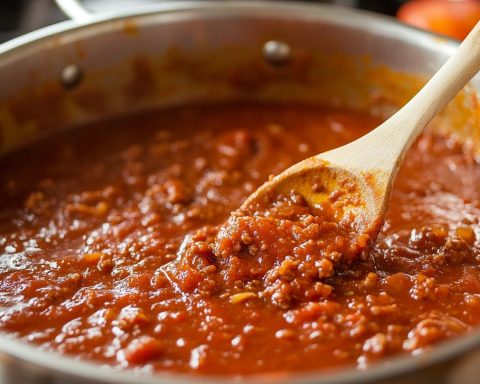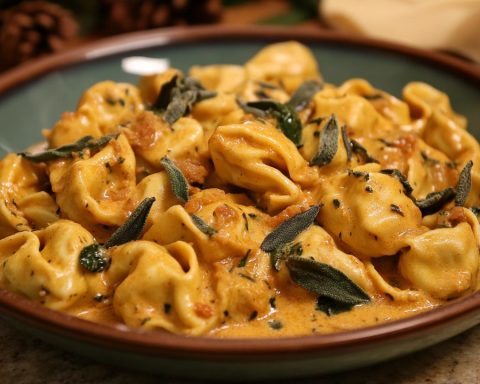In the heart of autumn, as the leaves transform into a vibrant tapestry of reds, oranges, and yellows, hearty dishes take center stage in homes across Slovenia. One such beloved creation is the Polnjena Hokaido Buča—a dish that encapsulates the cozy essence of the season. This stuffed Hokkaido pumpkin boasts a perfect balance of nutty sweetness from the creamy pumpkin flesh and the rich, satisfying flavors of its savory filling. Traditionally served as a centerpiece for family gatherings or autumnal celebrations, this dish is both eye-catching and soul-warming.
The Hokkaido pumpkin, known for its vivid orange hue and edible skin, is a small yet mighty gourd, offering ample room for creativity. Its origins trace back to the lush fields of Japan, where it was first cultivated before finding its way into European kitchens. In this Slovenian-inspired version, the pumpkin is lovingly filled with a blend of rice, vegetables, herbs, and cheese, creating a harmony of flavors that is as delightful as the crisp fall air.
Ingredients:
– 1 medium Hokkaido pumpkin, approximately 1.5 kilograms (3.3 pounds)
– 1 cup of cooked rice (any variety you prefer)
– 1 medium onion, finely chopped
– 2 cloves of garlic, minced
– 1 red bell pepper, diced
– 1 zucchini, diced
– 200 grams (7 ounces) of mushrooms, chopped
– 100 grams (3.5 ounces) of feta cheese, crumbled
– 1/4 cup of grated Parmesan cheese
– Fresh thyme and rosemary, finely chopped (about 1 teaspoon each)
– Salt and pepper to taste
– 2 tablespoons of olive oil
– 1 tablespoon of butter
Instructions:
1. Prepare the Pumpkin: Preheat your oven to 190°C (375°F). Carefully cut off the top of the Hokkaido pumpkin to create a lid and set it aside. Scoop out the seeds and fibrous strands to create a clean cavity for the filling. Lightly season the inside with salt and pepper.
2. Cook the Vegetables: In a large skillet, heat the olive oil over medium heat. Add the chopped onion and minced garlic, cooking until they become translucent and fragrant. Incorporate the diced red bell pepper, zucchini, and mushrooms, sautéing until they are tender and slightly caramelized.
3. Mix the Filling: In a large mixing bowl, combine the sautéed vegetables with the cooked rice, crumbled feta cheese, grated Parmesan, and fresh herbs. Add salt and pepper to taste, adjusting the seasoning according to your preference.
4. Stuff the Pumpkin: Spoon the filling mixture generously into the hollowed pumpkin, pressing down gently to pack it tightly. Replace the pumpkin lid.
5. Bake to Perfection: Place the stuffed pumpkin in a baking dish and dot the surface with butter. Roast in the preheated oven for about 1 hour, or until the pumpkin is tender and can be easily pierced with a fork.
Cooking Tips:
– Ensure the Hokkaido pumpkin is evenly cooked by rotating it halfway through the baking time.
– For a richer flavor, add a handful of toasted pine nuts or walnuts to the stuffing mixture.
Serving Suggestions:
Allow the stuffed pumpkin to cool slightly before slicing it into generous wedges. Serve with a crisp green salad and a crusty loaf of bread for a hearty meal that captures the essence of autumn. Pair with a light, fruity white wine such as a French Sauvignon Blanc to enhance the dish’s flavors.
Whether enjoyed as part of a festive feast or a cozy family dinner, this Polnjena Hokaido Buča promises not only to delight the palate but also to warm the heart, one delicious bite at a time.
The Untold Secrets of Slovenia’s Beloved Polnjena Hokaido Buča!
As the golden hues of autumn drape Slovenia’s picturesque landscapes, the culinary world revels in the hearty embrace of the Polnjena Hokaido Buča. But did you know this seemingly simple dish harbors fascinating historical nuggets and culinary controversies?
Although widely associated with Slovenia, the roots of the Hokkaido pumpkin trace back to Japan, offering a cultural fusion that intrigues food enthusiasts. Brought to Europe in the early 20th century, the Hokkaido pumpkin quickly became a staple in Slovenian cuisine. Its edible skin, a rare feature among squashes, sparks a continual debate: to peel or not to peel? Many chefs argue that leaving the skin intact not only enhances the dish’s nutty flavor but also retains essential nutrients.
Another lesser-known fact lies in the varied interpretations of the traditional filling. While many households stick to rice and vegetable combinations, some enthusiasts are exploring unconventional additions such as quinoa or bulgur for a modern twist. This gastronomic flexibility has sparked spirited discussions among traditionalists and culinary innovators alike.
Controversy Corner: Can Sweet or Savory Win?
A fascinating twist on Polnjena Hokaido Buča involves transforming it into a dessert. By swapping out the savory filling for sweet ingredients like apples, cinnamon, and walnuts, chefs offer a delightful surprise that has contested its savory counterpart. This controversial move raises a crucial question—should traditional dishes evolve to include diverse palates, or should they adhere to their classic roots?
For more fascinating cultural tidbits, check out Visit Ljubljana and explore the rich history of Slovenian cuisine on Slovenia.si.








